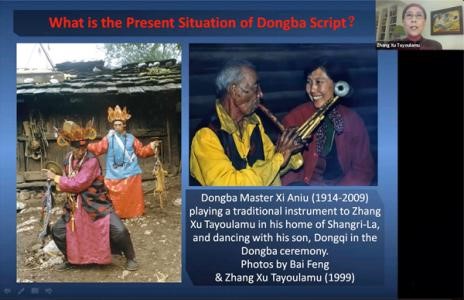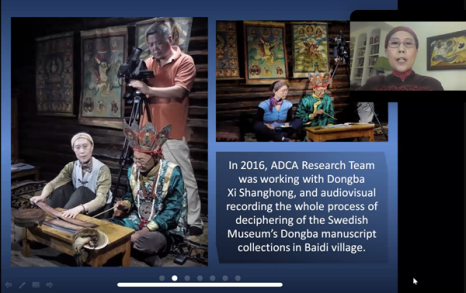Dongba script highlighted on UN's Chinese Language Day
- By Wang Yiming
 0 Comment(s)
0 Comment(s) Print
Print E-mail China.org.cn, April 22, 2021
E-mail China.org.cn, April 22, 2021
A one-hour language class on the Dongba script, one of the pictographic writing systems still in use today, was held online on Tuesday as part of a series of events to mark the United Nations' annual Chinese Language Day.
The lecture titled "Mysterious Dongba Script," jointly hosted by the UNSRC Chinese Book Club and the Beijing Association of Dongba Culture and Arts (ADCA) is one of the three livestreamed events focusing on Chinese pictographs.

The Dongba script was developed and used by the Naxi people in China's Yunnan province. In 2003, UNESCO admitted the Naxi Dongba manuscripts into its Memory of the World Register.
The guest speakers briefed the audience about the history and present state of the Dongba script and taught a few basic examples of the intricate writing system.
"In ancient times, the Naxi people were a non-literate ethnic group who passed down their culture through oral inheritance. But after the Naxi settled down, these industrious people made paper from bark, pens from bamboo, and the ink from soot and then created a unique pictographic script based on the many forms of nature," said Zhang Xu, a Naxiologist and the head of the ADCA, a non-governmental organization working to protect, research, and revive Dongba culture.
"The Dongba shamans left more than 20,000 volumes of Dongba manuscripts in their mysterious pictographs, which are composed of approximately 1,400 individual characters," Zhang introduced.
However, many manuscripts were burned and very few Dongba shamans with a deep understanding of the script remain. According to Zhang, the ADCA spent years collecting, deciphering, and digitizing the remaining manuscripts scattered across the world.

"Hidden behind the mysterious Dongba script are traces of the thoughts of the Naxi ancestors. This kind of most primitive form of picture writing shines a light on and explores how human civilization emerged and evolved," Zhang said.
Duncan Poupard, assistant professor at the Department of Translation of the Chinese University of Hong Kong and whose research centers around the translation of Chinese minority texts, specifically those of the Naxi minority, taught some Naxi language dialogue and showed the audience examples of pictographs that can still be seen in Lijiang's Old Town, Yunnan province.
"If you enter from the main square of Lijiang, you will see a large multi-scriptural stone with Chinese, English, and Naxi Dongba," the professor described. "I think examples like this show language revitalization in action. The old Dongba shamans were dying out, but the pictographs are still alive in the town."

The lecture attracted over 100 participants with an interest in the ancient language of Dongba from countries across the world.
The UN Chinese Language Day was established by the UN Department of Public Information in 2010, seeking "to celebrate multilingualism and cultural diversity as well as to promote equal use of all six of its official working languages throughout the organization."
The date for the Chinese Language Day was chosen "to pay tribute to Cangjie, a mythical figure who is said to have invented Chinese characters about 5,000 years ago."






Go to Forum >>0 Comment(s)